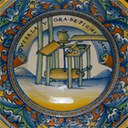0084 Mechanical Disegno
Identifiers (Article)
Identifiers (Files)
Abstract
The article argues that the debate around Italian Renaissance disegnohas tended to overemphasize the rhetoric promoting a separation between design and execution, mind and body, and asserting a hierarchy of the arts constructed on the friction between intellectual andcorporeal engagement in the making of artefacts. Building on written sources such as so-called "technical treatises" and on objects taken as evidence of the design process, it is suggested that we should consider instead a more integrated, organic, technologically engaged and "mechanical" notion of disegno, in which design might be seen to grow within a physical environment from the interconnection of human action and materials. Using Renaissance pottery as a case study, and exploring its understanding within different linguistic, literary and material contexts, the article proposes an epistemology allowing for greater fluidity, overlap and communality between supposedly distinct arts.
Statistics


License

This work is licensed under a Creative Commons Attribution-NonCommercial-NoDerivatives 4.0 International License.



